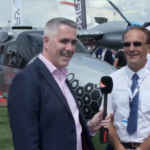Aircraft will demonstrate advanced surveillance capabilities with SCAR pods and Leonardo Osprey Radar System
Viking Air Ltd’s intelligence, surveillance and reconnaissance variant, the Twin Otter Guardian 400, will be undertaking a world tour this autumn to demonstrate its capabilities.
The aircraft had been developed in partnership with key companies in the maritime patrol and search and rescue sectors.
SCAR pod features advanced surveillance capabilities
The demonstrator aircraft features a right-hand SCAR pod with Hensoldt Argos EO/IR imaging turret, multi-spectral HDTV camera, mega-pixel HD Thermal imager, laser range finder, multi-mode auto tracker, and Remote Image Bus (RIB) video feed for display on the cockpit MFD or crew workstation. The demonstrator will also feature a left-hand SCAR pod with Leonardo Osprey Radar System and Sentient Vidar Camera system.
The Guardian 400 prototype is also equipped with an Airborne Technologies’ tactical workstation with high-definition touchscreen monitors, data/voice/video recorder, Mission Management Unit (MMU), mission radio communications, intuitive hand controller for MCU & SLR camera targeting, CarteNav AIMS mission system software, Kestrel MTI targeting software, and IKHANA ergonomic mission seat for optimised crew comfort. The prototype will also be equipped with Viking conformal bubble windows, left and right wing-mounted hard points by IKHANA, Thunder Bay Aviation stretcher racks, and an aft lavatory.
System feeds can identify small objects in water
Director of International Marketing, David Heath, explained that the optical radar capabilities of the Guardian 400, together with the system feeds to the console panel, would enable operators to detect small objects in the ocean, such as a human head or upturned small boat. He added that the advanced search and rescue and patrol capabilities and interior configurations, combined with the Twin Otter’s ability to land on water, would enable its capabilities as a cost-effective search aircraft.
“When you look at the operating and acquisition costs of a Twin Otter compared to a 6 tonne helicopter or a large turboprop, then you can multiply your capability by having a suite of Twin Otters, not necessarily to replace existing assets that you have, but to supplement them at a lower cost.”
Heath added: “We hope to build on the experience that our military and government operators already have with the Twin Otter worldwide in showing the aircraft’s capabilities.”
Heath said the new variant was built on the aircraft’s existing intelligence capabilities. The Twin Otter is already operating as a search and rescue and maritime aircraft in Vietnam, United Arab Emirates, Peru, Panama and Qatar.
“We are not starting from scratch, we are just offering some new capabilities with the SCAR pods and the Twin Otter which we think makes it an even more attractive asset.”

